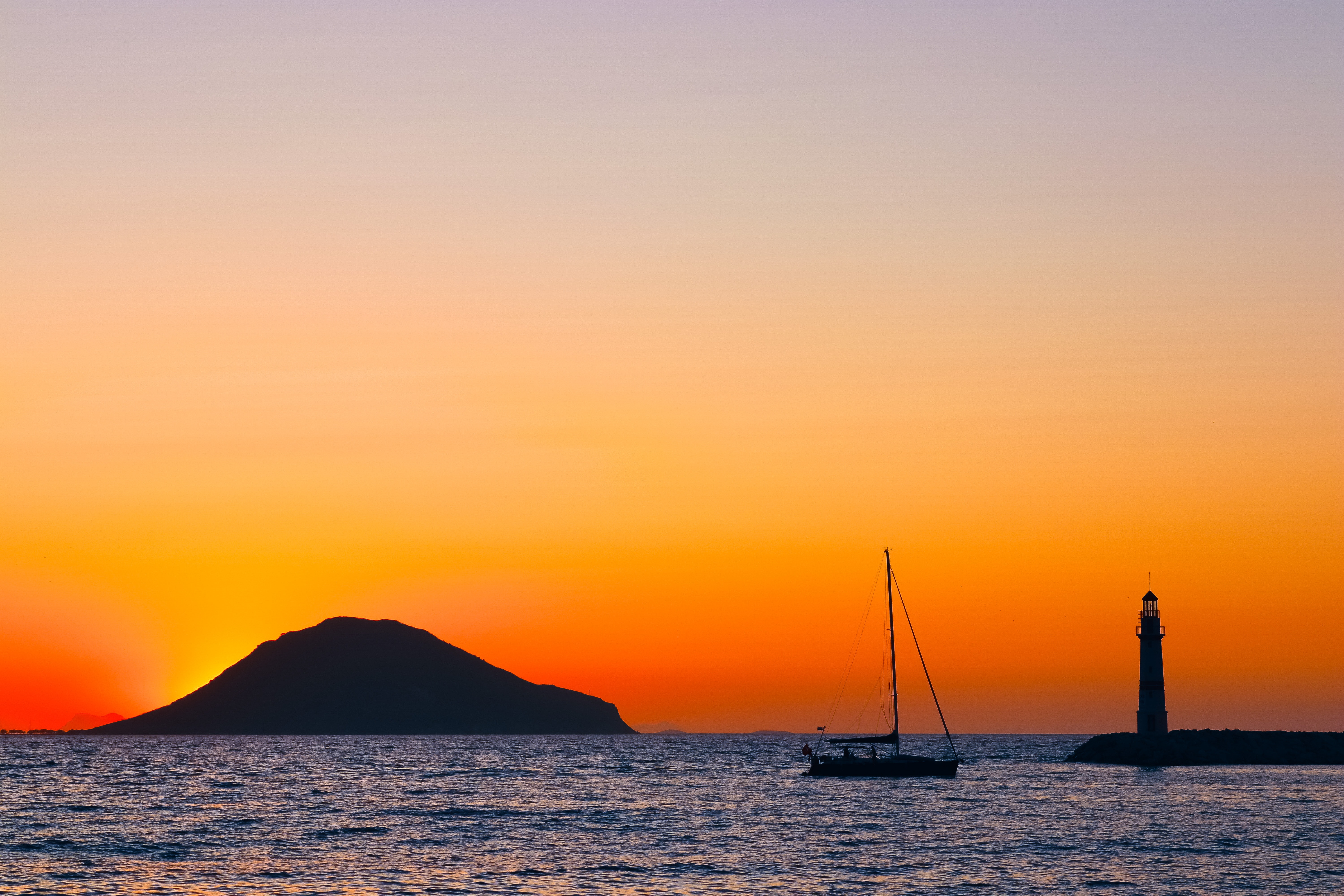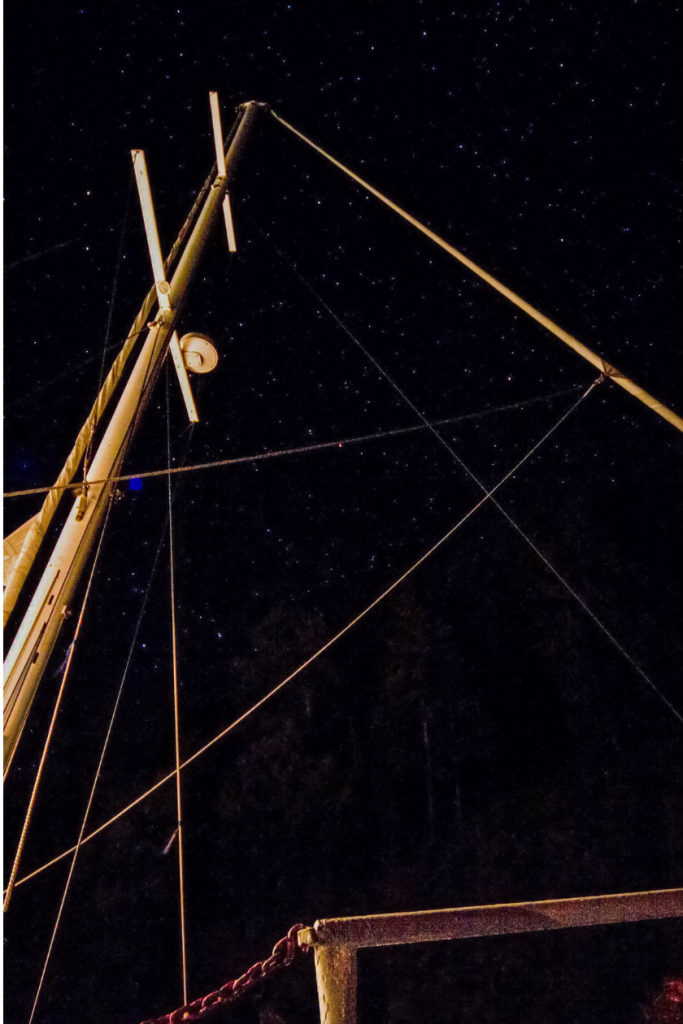Night Sailing Doesn’t Have to Be Scary
September 2nd, 2022 by team

by B.J. Porter (Contributing Editor)
Sailing offshore under a sea of stars is an experience beyond compare. On a clear, moonless night, you’ll never see more stars from anywhere on earth. With nothing but the wind in the sails and the sounds of the boat for accompaniment, it’s a peaceful yet exhilarating experience. Add the soft puff of dolphins breathing off your aft quarter and their shapes like glowing torpedoes in the phosphorescent foam, and it’s hard not to wax a little poetic.
On the other hand, sailing close to shore at night in busy waters can be a panic inducing experience if you haven’t planned to be out late. There’s a reason most charter companies don’t let their customers sail at night – it can be dangerous if you’re not prepared and don’t know where you’re going.
But if you know what to expect and you’re ready for it, you can capture some of that offshore magic close to home.
It Looks Different at Night

One of the first things you see after dark, especially with no moon, is that the waters in front of you look different. Distances are very hard to judge, especially lighted buoys which all sort of look the same in a sea of green and red flashing lights. Unlit land is hard to see, and when you see it, it looms out from the darkness and you can’t tell how far away it is.
If you look long enough, you can filter out some of the noise and pick out individual lights, and in your home waters you’ll be able to identify those same comfortable marks you sail by on sunny weekends. Buoy lights are bright and look similar even when they’re far apart, but the careful eye can discern which look a little closer, and you’ll be able to make sense of them by comparing them to the charts.
You’ll need to rely on your eyes, but they can fool you since distances are harder to judge on dark nights. They’re not your only sense, and you’ll need to look at your charts and instruments.
Be very careful with your night vision. Your eyes will adapt to the darkness, so don’t use too many bright, white lights to look at things, and leave the cabin and cockpit lights off. If you have lights on in the cockpit, you won’t be able to see outside your own boat.
Plan to Stay Up Late

Some of us had our first low light sailing experiences unintentionally. Poor planning meant you sailed too far to get back before dusk, or something delayed the trip back to your slip and you stayed out late. This can be unnerving if you haven’t done it before.
We can usually control when we sail, and if you want to get comfortable sailing after dark the best way is to plan a night trip in comfortable waters to get that first one behind you and get a feel for what moving your boat at night feels like.
Study the charts
Charts tell you everything you need to know about every fixed mark and hazard around you. You’ll see light patterns and timing laid out, and you should review these as you prepare. If you don’t understand what a marking on a buoy means, look it up so you know. You’ll see things like Fl (2 + 1) G 6s or Fl R 2.5s that uniquely identify every buoy by lighted pattern.
Not every buoy is lit, but they’re all numbered with reflective letters. Find all the buoys you normally use for daylight sailing and make a list for quick reference. Since you’ve never seen them at night, it’s important to know where your usual navigation aids are. Memorize the patterns if you can, but don’t rely on your memory for the first time.
A paper chart is very helpful for this kind of pre-trip study if you have one. It’s easier to see the big picture and what lights may be near what lights.
Plot a Course
One of your best techniques for safe nighttime navigation is a safe, conservatively plotted course. It doesn’t matter if you’re doing a trip you’ve done a dozen times in daylight with line-of-sight navigation. Take the time to plot a course for your night trip, because the line-of-sight you’re used to no longer applies.
Plot a very conservative course. Don’t drop waypoints on top of marks, or even too close to them. Stay near the middle of channels and well wide of any hazards, even if it’s a little more sailing. It’s easy to misjudge distances at night, and you want to leave a lot of room for error. If you have a clear or moonlit night and can spot marks easily, you can always sail closer than your plot.
Learn ship lights

If you plan to do much night sailing, it’s wise to drill yourself on the combinations of ship’s lights and their meanings. You don’t want to stumble behind a fishing boat in the dark or put yourself between a barge and a tow. Every boat on the water at night has lights that tell you what they are and what they are doing. So get a reference card for the most common lights and study it, and keep it in the cockpit.
One of our best uses for imaged stabilized binoculars was night sailing. They can turn a faint blob of light on the horizon into a distinct pattern of lights, which you can read to identify the vessel’s course and what they might do.
Gear up for the night
You’re going to need flashlights, of course. But a little thought to what type of gear you carry can make your life a lot easier.
We like headlamps because they keep your hands free. The best headlamps are bright and have both red and white lights as options. Red lights don’t wash your night vision, so they’re good for many working tasks instead of losing your night vision with a brighter light. We put multi-color lights in our cockpit so we could have red working lights overhead.
But headlamps aren’t great for seeing things far off, so you’ll want a few powerful lights with focusing beams, and a spotlight in case of emergency. A small, powerful flashlight with a focused LED beam can reflect on a navaid quite far from the boat, and is your best tool for spotting unlit marks in the dark by flashing the reflective letters.
Keep sound signals handy, too. Your running lights are your primary means of being seen, but if someone gets too close, they may not have seen them.
Use All Your Tools

Your eyes are your first best line of defense, but you should use every tool you have on your boat. If you have radar, use it. It makes finding marks easier and will spot any unlit hazards. Don’t be surprised if you see fools on the water without lights. It happens all the time and radar will spot all but the smallest dinghies.
Trimming Sails
Night sail trim is tricky, but sailing instead of motoring at night is really nice. Not only is the experience a little otherworldly, the quiet helps you listen for marks with sound and other boats.
The challenge lies in trimming a sail you can’t see very well. The second you put a bright light on the sail to have a look at it, you’ll blind everyone who wasn’t expecting it. A red LED flashlight helps avoid night blindless from checking your sails, but be aware that your port side tell-tales may be difficult to see in red light.
With some moonlight or bright stars, you’ll still be able to see the general shape of your sails, but you may need to use a little light now and then for gross trim.
Watching for Boats
With radar on, you should see most boats. If you have someone you can designate as the radar operator, do it. But most pairs of eyes should look outside the boat most of the time. Watch and listen; just like sailing in fog, you can hear well on the water at night and an engine can tip you off to a fast moving hazard.
Identifying Hazards
Government marks will be your best clue for dangerous spots, so identifying them correctly in the distance is an ongoing process all night. Search them out by light pattern, and keep track of them.
You may find hazards on radar that are not on the chart. Be very careful of unlit hazards. If you see something looming at you in the dark, look for it on radar, but don’t be shy about lighting it up with that spotlight.
Remember – distances are deceptive at night, especially on very dark nights.
- Posted in Blog, Boat Care, Boating Tips, Cruising, Fishing, iNavX, Navigation, Reviews, Sailing, Sailing Tips
- No Comments


Leave a Reply